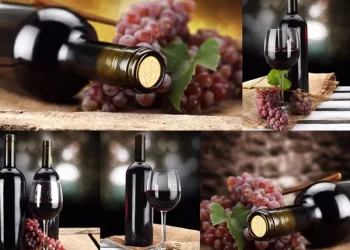The color of a wine can be used to judge the richness and lean of the wine body, and can also be used to judge the cellaring potential of the wine.
For example, if a syrah has blue edges, it indicates low acidity, which means the wine will cellaring well.
Acidity is one of the main factors in cellaring a wine.
It can be seen that learning to see the color of wine is very important for you to appreciate the wine.
Let’s take a look at the color of wine.
1. Lighter red wines Lighter red wines tend to have higher acidity and lower tannin content and range in body color from magenta to garnet, such as Pinot Noir, St. Laurent, Zweigelt and Gamay.
2. Medium-bodied red wines Medium-bodied red wines usually have medium-strength acidity and tannins.
The wine has a wide range of colors, including Merlot, Sangiovese and Zinfandel.
3. Heavy – bodied red wines are typically high in tannins and slightly low in acidity.
These wines are highly refined and opaque, such as Syrah, Malbec, Mourvedre and Cabernet Sauvignon.
4, the elderly portion of red wine when the peak of a red wine over, its color will become dark brown.
Many wines are preserved for more than 20 years without much change in color.
Merlot and Nebbiolo are more prone to brick-red colors than other grape varieties.
A wine with a blue rim, like syrah, indicates a higher pH, which means a lower acidity.
5. The color of Rose wine Rose wine is made from conventional red grape varieties such as Muhe White, but the skin is infused for a short time, so the body color of rose wine is very light. The body color of rose wine ranges from light salmon red (Pinot noir) to magenta (Grenache).
1. Light-bodied white wine The color of light-bodied white wine ranges from colorless to greenish yellow.
Most wines of this type are good to drink when young and cold, such as Pinot Grigio, Albarino, Vinho Verde and Muscadet.
2. Medium bodied white wines Most white wines are medium bodied white wines with a light golden color, such as Sauvignon Blanc, Chardonnay and Chenin Blanc that have not been aged in oak barrels.
3. Full-bodied white wines The color of white wines can be derived from both the artescent juice of red grape varieties such as Pinot noir and the highly refined essence of white grape varieties.
These wines, such as Chardonnay, Viognier and Marssanne, are typically low in acidity and aged in oak barrels to add cream and vanilla aromas.
4, the elderly portion of white wine rarely white wine aging time can be more than 12 years.
Old bottles of white wine lose their color and become dull over time.
Because white wine is so sensitive to light, it turns brick red in color over time.
The latest market dynamics at any time to see, please pay attention to.












































